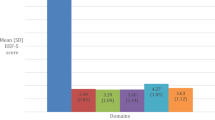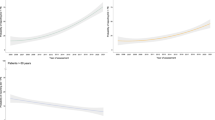Abstract
Erectile dysfunction (ED) can be an early and first sign of an underlying systemic disease. A screening program is offered by the Israeli Defense Force for career servicemen at the staff periodic examination center (SPEC), the aim of which was early detection of morbidity. We introduced the Sexual Human Inventory for Males (SHIM) questionnaire, in order to detect examinees with ED, and offer them suitable treatment options. The purpose of this study is to introduce the concept of an ED questionnaire as part of a screening program, and to describe the first months of its implementation. A computerized questionnaire is used to collect the medical history. The SHIM questionnaire was incorporated into the medical questionnaire. Relevant data including compliance to reply, SHIM scores, age and accompanying diseases of patients were collected from the computerized database of SPEC. A total of 2182 patients reported to SPEC from 1/5/01 to 1/11/01, 1980 of whom were males. Of the males, 881 (44.5%) chose to fill the SHIM questionnaire (mean age 34.5±6.7 y), and 244 of them (27.7%) had a score of 21 or less (20.7% had 17–21, 5.7% 11–16, 1.4% 0–10). The prevalence of ED and its severity increases with age. An inverted linear correlation was found between age and SHIM score (r=−0.22, P<0.0001). Prevalence of hypertension and diabetes mellitus is higher in patients with SHIM score ≤16 compared to those with a score ≥22. Only 15% of men with ED refer themselves for medical help. The concept of adding an ED questionnaire to a screening program may encourage more men to seek treatment, not only for their ED, but also for the underlying disease. The platform of a periodic examination offers maximum privacy to the examinees, resulting in better cooperation.
This is a preview of subscription content, access via your institution
Access options
Subscribe to this journal
Receive 8 print issues and online access
$259.00 per year
only $32.38 per issue
Buy this article
- Purchase on Springer Link
- Instant access to full article PDF
Prices may be subject to local taxes which are calculated during checkout


Similar content being viewed by others
References
National Institutes of Health. NIH Consensus Development Panel on Impotence. Impotence. JAMA 1993; 270: 83–90.
Feldman HA et al. Impotence and its medical and psychosocial correlates: results of the Massachusetts Male Aging Study. J Urol 1994; 151: 54–61.
Lauman EO, Paik A, Rosen RC . Sexual dysfunction in the United States: prevalence and predictors. JAMA 1999; 281: 537–544.
Ansong KS, Lewis C, Jenkins P, Bell J . Help-seeking decisions among men with impotence. Urology 1998; 52: 834–837.
Wierman ME, Cassel CK . Erectile dysfunction: a multifaceted disorder. Hosp Pract (Off Ed) 1998; 33: 65–74, 77–78, 83–89; discussion 89–90.
Kirby M, Jackson G, Betteridge J, Friedli K . Is erectile dysfunction a marker for cardiovascular disease? Int J Clin Pract 2001; 55: 614–618.
Lue TF . Erectile dysfunction. New Engl J Med 2000; 342: 1802–1813.
Beck LH . Periodic health examination and screening tests in adults. Hosp Pract (Off Ed) 1999; 34: 117–118, 121–122, 124–126.
Vroege JA . The sexual health inventory for men (IIEF-5). Int J Impot Res 1999; 11: 177.
Day D, Ambegaonkar A, Harriot K, McDaniel A . A new tool for predicting erectile dysfunction. Adv Ther 2001; 18: 131–139.
Rosen RC et al. Development and evaluation of (an) abridged, 5-item version of the International Index of Erectile Function (IIEF-5) as a diagnostic tool for erectile dysfunction. Int J Impot Res 1999; 11: 319–326.
Rhoden EL, Teloken C, Sogari PR, Vargas Souto CA . The use of the simplified International Index of Erectile Function (IIEF-5) as a diagnostic tool to study the prevalence of erectile dysfunction. Int J Impot Res 2002; 14: 245–250.
Virag R, Boully P, Frydman D . Is impotence an arterial disorder? Lancet 1985; 1: 181–184.
Levine LA, Kloner RA . Importance of asking questions about erectile dysfunction. Am J Cardiol 2000; 86: 1210–1213.
Marwick C . Survey says patients expect little physician help on sex. JAMA 1999; 281: 2173–2174.
Baldwin KC . Under reporting of ED among men with unrelated urologic conditions. J Urol 2000; 163(Suppl 4): 243, (abstract 1080).
Cappelleri JC et al. Relationship between patient self-assessment of erectile dysfunction and the sexual health inventory for men. Clin Ther 2001; 23: 1707–1719.
Kinsey AC, Pomeroy W, Martin C . Age and sexual outlet. In: Kinsey AC (ed). Sexual Behavior in the Human Male. WB Saunders: Philadelphia, 1948, p 218.
Dewire DM . Evaluation and treatment of erectile dysfunction. Am Fam Physician 1996; 53: 2101–2106.
Moreira Jr ED et al. Prevalence and correlates of erectile dysfunction: results of the Brazilian study of sexual behavior. Urology 2001; 58: 583–588.
Burchardt M et al. Hypertension is associated with severe erectile dysfunction. J Urol 2000; 164: 1188–1191.
Roth A et al. Prevalence and risk factors for erectile dysfunction in men with diabetes, hypertension, or both diseases: a community survey among 1,412 Israeli men. Clin Cardiol 2003; 26: 25–30.
Author information
Authors and Affiliations
Corresponding author
Rights and permissions
About this article
Cite this article
Heruti, R., Yossef, M. & Shochat, T. Screening for erectile dysfunction as part of periodic examination programs—concept and implementation. Int J Impot Res 16, 341–345 (2004). https://doi.org/10.1038/sj.ijir.3901173
Received:
Revised:
Accepted:
Published:
Issue Date:
DOI: https://doi.org/10.1038/sj.ijir.3901173
Keywords
This article is cited by
-
Current State of Endovascular Treatment for Vasculogenic Erectile Dysfunction
Current Cardiology Reports (2013)



